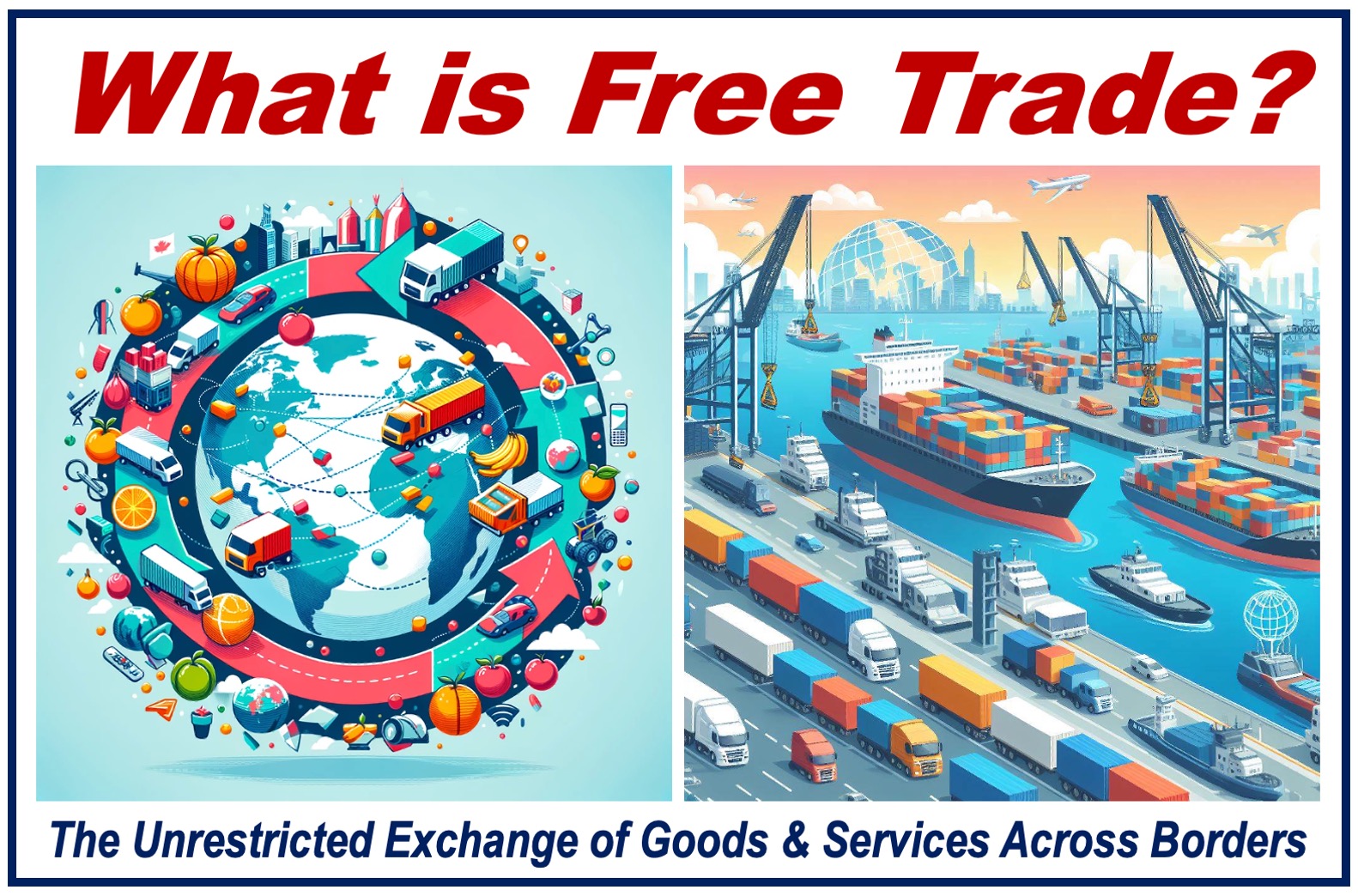Listen to this article.
If you believe in the sale and purchase of goods and services across international borders with little to no government tariffs, quotas, subsidies, or prohibitions to limit their exchange, you believe in Free Trade.
We refer to tariffs, quotas, subsidies, etc. as trade barriers. Proponents of pure free trade would like to see no trade barriers at all.
Believers in free trade say that there should be a more efficient allocation of resources globally. They say that this would lead to greater economic growth, lower prices for consumers, more choice, and better quality products.
Wikipedia.org has the following definition of the term:
“Free trade is a trade policy that does not restrict imports or exports. In government, free trade is predominantly advocated by political parties that hold economically liberal positions, while economic nationalist and left-wing political parties generally support protectionism, the opposite of free trade.”
Free trade vs. protectionism
The opposite of free trade is protectionism.
A country that imposes high tariffs and widespread quotas on imports is protectionist. It believes that by imposing trade barriers, it is protecting local companies and jobs.
However, over the long-term, protectionism undermines economic growth. None of the world’s most protectionist nations are among the ten or twenty wealthiest, i.e., their citizens’ standards of living are low.
- Comparing countries
North Korea, Cuba, and Venezuela, for example, have adopted protectionist policies, contrasting with the United Kingdom, Germany, Japan, and Australia, which embrace a more free trade-oriented approach. Generally, the latter group of countries enjoys higher levels of economic prosperity. Other factors also play a part in the difference in standards of living, apart from international trade.

Competitive advantage
Free trade, at its core, is founded on the concept of competitive advantage. This principle suggests that you should produce and export goods and services that you are best at, and import goods that would be more expensive to produce at home.
By doing so, your country can specialize in certain industries, leading to more efficient production and a boost in economic output.
Critics of free trade
Some people say that if their government imposed no tariffs, quotas, or other barriers of trade, it would lead to job losses in domestic industries that cannot compete with imported goods.
Other critics raise concerns about the environmental impact of transporting goods over long distances, and also the potential for lower labor standards.
Supporters of free trade, however, argue that protectionism allows second rate companies to continue operating in the marketplace, that is, it rewards producers of inferior goods. Ultimately, they say, the economy suffers, as do consumers.
Innovation
Economists say that the more a country trades freely, the more it fosters innovation. With competition, companies are pushed to innovate to maintain or boost market share.
Free trade leads to better products and services, further benefitting consumers.
Challenges
However, there are some challenges when a country operates in the international marketplace without trade barriers for the first time. Adjusting to global competition requires flexibility from workers and industries.
The government may need to implement policies to support workers who suffer because of these changes, through retraining programs or education.
In practice, pure free trade does not exist. All governments worldwide impose some trade barriers to either protect their industries, respond to other countries’ unfair practices, or due to domestic political pressures.
Free trade areas
Below is a list of prominent free trade areas across the world, including their foundation dates and very brief descriptions:
- European Union (EU)
Founded in 1993. A political and economic union of 27 European member states. - North American Free Trade Agreement (NAFTA)
Founded in 1994, replaced by the USMCA in 2020. A trade deal between the USA, Canada, and Mexico. - Association of Southeast Asian Nations (ASEAN) Free Trade Area (AFTA)
Established in 1992. Aims to eliminate tariffs within ASEAN member countries. - Southern Common Market (Mercosur/Mercosul)
Founded in 1991. A South American trade bloc. - Caribbean Community (CARICOM) Single Market and Economy (CSME)
CARICOM established in 1973, CSME developed in the early 2000s. Targets economic integration in the Caribbean. - Common Market for Eastern and Southern Africa (COMESA)
Founded in 1994. A free trade area with nineteen member states in Africa. - Pacific Alliance
Founded in 2011. A Latin American trade bloc including Chile, Colombia, Mexico, and Peru. - East African Community (EAC)
Re-established in 2000. An intergovernmental organization of six countries in Eastern Africa. - South Asian Free Trade Area (SAFTA)
Founded in 2004. A trade agreement within the SAARC aiming to reduce customs duties among its members.
Video explanation
This video, from our YouTube partner channel – Marketing Business Network, explains what free trade means using simple and easy-to-understand language and examples.
Interesting Related Videos
These two interesting realted video presentations explain what ‘International Trade’ and ‘Trade Area’ are:
-
What is International Trade?
-
What is a Trade Area?
